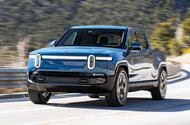Rivian’s Unique Approach to Electric Vehicles
Rivian has emerged as a notable player in the electric vehicle (EV) landscape, often drawing comparisons to Tesla. However, a closer look reveals that Rivian is carving out its own niche with a distinct philosophy and approach to vehicle design and software integration. This article explores Rivian’s innovative strategies, the features of its flagship model, the R1T, and the implications of its recent partnership with Volkswagen.
Rivian: More Than Just a Car Manufacturer
Founded in 2009 by RJ Scaringe, Rivian has evolved from a fledgling startup to a significant contender in the EV market. Unlike traditional automakers, Rivian positions itself primarily as a software company that manufactures vehicles. This perspective is underscored by the words of Wassym Bensaid, Rivian’s software chief, who emphasizes that software is integral to the vehicle’s design rather than an afterthought. This focus on technology allows Rivian to continuously enhance its vehicles through over-the-air updates, ensuring that they improve over time rather than becoming obsolete shortly after purchase.
The R1T: A New Kind of Pickup Truck
The Rivian R1T, launched in 2021, is noteworthy for being the first full-size electric pickup truck available in the U.S. market. Its design is softer and more approachable than that of its competitors, such as the Tesla Cybertruck, which is characterized by its aggressive and unconventional aesthetics. The R1T features a unique blend of functionality and charm, with elements like a flatbed that includes a mechanically closing cover and a spacious storage tunnel behind the rear seats.
The R1T is not just about looks; it boasts impressive performance metrics. The dual-motor models deliver 526 horsepower, while the quad-motor version produces a staggering 1,011 horsepower, enabling it to accelerate from 0 to 60 mph in under 2.5 seconds. This performance is complemented by a range of battery options, with the tri-motor version offering a range of 371 miles on a single charge.
Innovative Software and User Experience
Rivian’s commitment to software innovation is evident in the R1T’s user interface. The vehicle features a large, horizontally oriented touchscreen that controls everything from navigation to drive modes. While it lacks Apple CarPlay and Android Auto, the system is designed to be intuitive and engaging, with a focus on user experience. For example, the off-road mode provides extensive data, and the playful Gear Guard security mode adds a touch of personality to the interface.
The company has also shown a willingness to adapt based on customer feedback. Updates have included improvements to the vehicle’s suspension system, demonstrating Rivian’s ability to refine the driving experience through software adjustments rather than hardware changes.
Driving Experience: Comfort and Capability
During a test drive in the R1T, the vehicle’s comfort and capability were immediately apparent. The air suspension system effectively absorbs bumps, making it a pleasant ride even on less-than-ideal roads. The R1T’s weight and size do not hinder its performance; rather, it excels in multi-terrain conditions, showcasing its suitability for outdoor adventures. The regenerative braking system also enhances efficiency, allowing for better energy management during longer drives.
The Volkswagen Partnership: A Strategic Move
Rivian’s recent partnership with Volkswagen, which involves a significant investment and the establishment of a joint venture, marks a pivotal moment for the company. This collaboration aims to leverage Rivian’s software expertise alongside Volkswagen’s extensive manufacturing experience. Bensaid highlights that this partnership is not merely a one-way street; both companies bring complementary strengths to the table. Rivian’s agile, innovative culture combined with Volkswagen’s scale and resources could lead to groundbreaking advancements in the EV sector.
The joint venture will focus on developing vehicles on a new software-based platform, with the first model expected to be the production version of the ID. Every1 in 2027. This collaboration could reshape the landscape of electric vehicles, blending Rivian’s fresh approach with Volkswagen’s established presence in the automotive industry.
Rivian’s Vision for the Future
Rivian’s journey illustrates a shift in consumer expectations regarding electric vehicles. Today’s buyers are looking for more than just a car with an electric powertrain; they desire a comprehensive, software-driven experience. This evolving landscape presents both challenges and opportunities for traditional automakers, as they strive to adapt to the changing demands of the market.
In conclusion, Rivian stands out not only for its innovative vehicles but also for its commitment to integrating technology into every aspect of the driving experience. As the company continues to grow and evolve, its partnership with Volkswagen could serve as a catalyst for further advancements in the electric vehicle sector, potentially redefining what consumers expect from their vehicles in the years to come.

